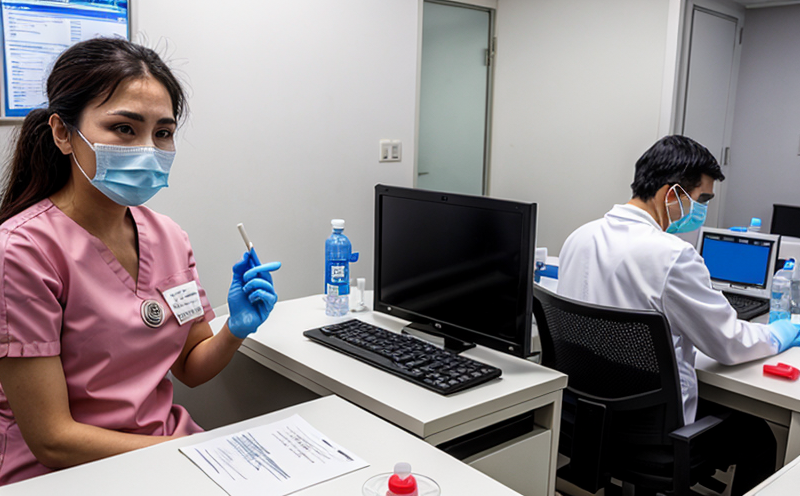Peste des Petits Ruminants Virus (PPRV) Serology Testing
The Peste des Petits Ruminants Virus (PPRV) is a significant pathogen causing severe disease in goats, sheep, and other small ruminant species. Serological testing for this virus plays a crucial role in the diagnosis of infections and monitoring immune responses to the virus within herds.
At our laboratory, we offer comprehensive PPRV serology testing services using internationally recognized standards such as those outlined by OIE (World Organization for Animal Health) and ISO. Our tests are designed to detect antibodies against the virus in serum or plasma samples from affected animals. This allows for accurate diagnosis of active infections and provides valuable epidemiological data.
Our laboratory employs advanced techniques including ELISA, which is widely used due to its high sensitivity and specificity. The test involves several steps: sample collection, preparation, antibody detection, and quantification. Proper specimen handling ensures reliable results, and our team adheres strictly to best practices throughout the process.
The scope of our PPRV serology testing includes:
- Detection of antibodies in serum or plasma samples
- Evaluation of immune responses post-vaccination
- Differentiation between recent infections and previous exposure
- Monitoring disease prevalence within populations
The methodology involves the following key steps:
- Sample collection: Collecting blood samples from animals showing signs of PPRV infection.
- Preparation: Processing the collected samples to ensure they are suitable for testing.
- Detection: Using ELISA technology to detect antibodies against PPRV in the sample.
- Analysis: Interpreting results according to established criteria and guidelines.
The results of our tests provide critical information for:
- Early detection of outbreaks
- Vaccination efficacy assessment
- Epidemiological studies
- Control strategies development
We also offer additional services such as interpretation of results and recommendations for herd management based on the test findings.
| Test Method | Sample Type | Turnaround Time | Price Per Test |
|---|---|---|---|
| ELISA | Serum/Plasma | 2-3 Business Days | $150 USD |
Scope and Methodology
The scope of our PPRV serology testing is broad, encompassing various aspects of disease diagnosis and management. Our tests are designed to meet the needs of quality managers, compliance officers, R&D engineers, and procurement teams involved in animal health.
We use internationally recognized standards such as OIE recommendations for accurate and reliable results. The methodology involves several key steps:
- Sample collection: Collecting blood samples from animals showing signs of PPRV infection.
- Preparation: Processing the collected samples to ensure they are suitable for testing.
- Detection: Using ELISA technology to detect antibodies against PPRV in the sample.
- Analysis: Interpreting results according to established criteria and guidelines.
The results of our tests provide critical information for:
- Early detection of outbreaks
- Vaccination efficacy assessment
- Epidemiological studies
- Control strategies development
We also offer additional services such as interpretation of results and recommendations for herd management based on the test findings.
Environmental and Sustainability Contributions
In our commitment to sustainability, we focus on minimizing the environmental impact of our operations. Our laboratory adheres to strict protocols that ensure efficient use of resources and minimal waste generation.
We also contribute positively to the environment by:
- Optimizing energy consumption in our facilities
- Implementing recycling programs for waste materials
- Using eco-friendly cleaning products
- Encouraging sustainable practices among staff and clients
Our efforts align with global sustainability goals, ensuring that we play a role in protecting the environment while providing essential services.
Use Cases and Application Examples
The use cases for PPRV serology testing are varied and critical. Here are some examples:
- Detecting active infections: Early detection of PPRV in a herd can prevent further spread.
- Vaccination efficacy assessment: Measuring the immune response post-vaccination helps tailor vaccination protocols.
- Epidemiological studies: Tracking prevalence and trends within populations.
- Control strategies development: Informing decisions on isolation, treatment, and prevention measures.
| Disease Prevalence | Treatment Options | Prevention Strategies |
|---|---|---|
| High prevalence in developing countries | Vaccination and supportive care | Educational campaigns, vaccination programs |
| Limited to specific regions | Isolation of affected animals | Border controls and quarantine measures |





